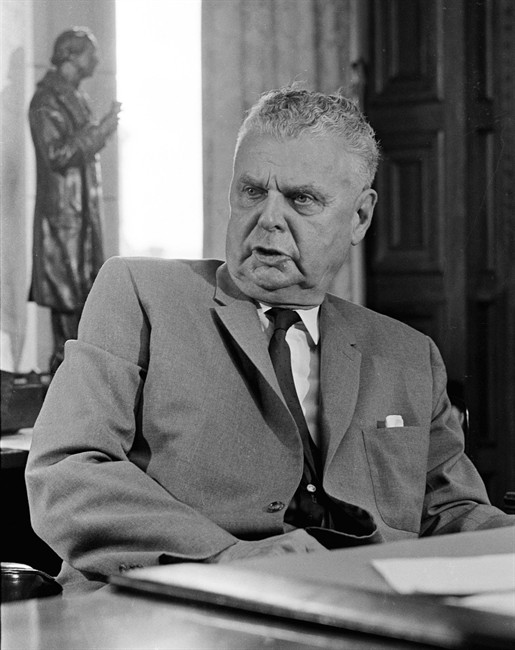OTTAWA – Half a century after his tumultuous six years as prime minister, John G. Diefenbaker’s name is being slapped on awards, ships and public buildings as the Harper Conservatives work to paint a little Tory blue into the country’s political memory.

“This iconic leader was chosen for his many contributions in shaping this country,” Public Works Minister Rona Ambrose said Monday as Ottawa’s old city hall on Sussex Drive was renamed in honour of the leader known as The Chief.
Canada’s 13th prime minister, who governed from 1957 to 1963, has been difficult to miss during the term of Canada’s 22nd prime minister.
Stephen Harper has consistently invoked Diefenbaker’s northern vision in speeches ever since coming to power, but the tributes haven’t been only rhetorical.
In 2008, Harper announced a new Polar-class icebreaker would be named after Diefenbaker. There’s a new human rights award in Dief’s name, and the Diefenbaker Canada Centre in Saskatoon received a $1.3 million government subsidy last year.
“Prime minister Diefenbaker’s passion and dedication to all Canadians has helped make this country a nation we can all be very proud of,” Foreign Affairs Minister John Baird said Monday as he dedicated a plaque and portrait that will adorn the newly named Ottawa building that houses some foreign affairs workers.
Noticeably absent from the Conservative address was any mention of the adjacent home of Canada’s Foreign Affairs Department, the Lester B. Pearson building – or “Fort Pearson” in local parlance.
And therein lies the rub.
- Roll Up To Win? Tim Hortons says $55K boat win email was ‘human error’
- Bird flu risk to humans an ‘enormous concern,’ WHO says. Here’s what to know
- Halifax homeless encampment hits double capacity, officials mull next step
- Ontario premier calls cost of gas ‘absolutely disgusting,’ raises price-gouging concerns
Canada has a Pearson airport and a Trudeau airport, Pearson high schools thither and yon, a Mount Trudeau in B.C., a Wilfrid Laurier University and Mackenzie King scholarships.
Liberal prime ministers governed Canada for 75 of the last 111 years and the spoils of power are reflected in the country’s public sphere.
Of course, there’s a Mount Diefenbaker too, and Macdonald-Cartier airports, bridges and highways, not to mention R. B. Bennett schools.
But political scientist Paul Thomas says there’s a long-held Conservative sense, especially in Western Canada, that Tory prime ministers have been given short shrift.
“Diefenbaker particularly was supposedly dismissed by the eastern elites as being a buffoon,” said the professor emeritus at the University of Manitoba – a perception he notes was reinforced with the recent release of old Jaqueline Kennedy interviews.
The wife of former U.S. president John F. Kennedy spoke of a 1961 official visit to Ottawa during which The Chief regaled them over lunch with stories of Winston Churchill, complete with impersonations. “It was just painful,” Kennedy says in the 1964 interview.
Harper’s sustained Diefen-mania, in the view of Thomas, “is redressing the balance.”
“Mr. Harper is exceedingly conscious of the symbols and communications around government and this continues a trend: We (Conservatives) now get to decide these matters and we’ll decide in our own favour.”
As Citizenship and Immigration Minister Jason Kenney told a conservative audience last week in Edmonton: “We have changed our perception of what it means to be Canadian.”
Those perceptions are shifted through myriad government efforts, ranging from a new citizenship guide to the renaming of the air force and navy to restore the “Royal Canadian” moniker.
Thomas says he was hard-pressed to understand Harper’s end game during five years of minority rule, but increasingly sees evidence of a prime minister “standing for … both big ‘C’ Conservative causes and smaller ‘c’ conservative causes – like law and order, stability within society and the Conservative party’s history and traditions.”
What looked in a minority government scenario like pre-emptive election positioning by the Conservatives is really “a new era of ‘permanent campaign’, in which techniques for winning power have been transferred increasingly to the process of government,” Thomas argued in an academic paper, “Communications and Prime Ministerial Power,” he wrote last spring.
“They’re going to invent ways to ensure they get the maximum mileage out of their new position of power and that they get maximum political credit and they become the ‘natural governing party,'” Thomas said of Harper’s Conservatives.
“That seems to be his long-term goal.”



Comments